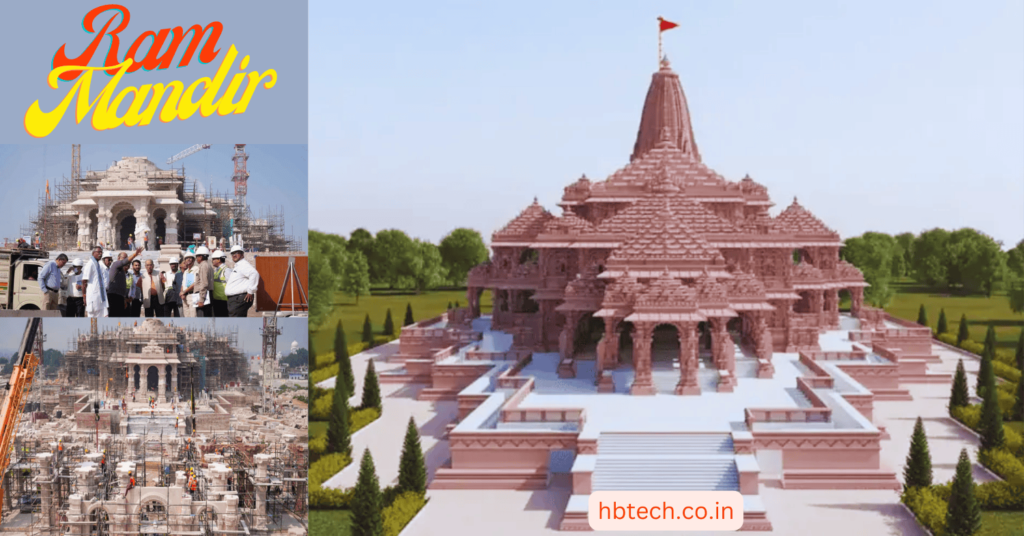Ram Mandir Ayodhya
The Ram Mandir is an important Hindu temple under construction in Ayodhya, Uttar Pradesh, India. It is built at the site considered to be the birthplace of the major deity in Hinduism, Lord Rama, replacing the Babri Masjid that previously stood there.
On January 22, 2024, the consecration ceremony for the idol of Lord Rama, known as Ram Lalla, will take place at the Ram Temple in Ayodhya. Here are some key features of the temple:
- The temple is being constructed in the traditional Nagar style of architecture.
- The total area of the main temple is 2.7 acres.
- The temple’s overall dimensions are 360 feet in length and 235 feet in width.
As per the Shri Ram Janmabhoomi Tirth Kshetra Trust, the temple will have five halls, incorporating a dance hall, a color hall, and a meeting hall.
The Ram Mandir in Ayodhya is a very important religious place for Hindus all around the world. But its history is a bit complicated and connected to India’s social and political situation. In this blog post, we’ll explore the story of the Ram Mandir, from where it started to where it is being built now.
Ram Janmabhoomi
Ayodhya is a city in Uttar Pradesh, India, that is very important for Hindus because they believe it is the birthplace of Lord Rama, a highly respected deity in Hinduism. Rama, the main character in the epic Ramayana, is seen as an incarnation of Lord Vishnu. The place where they are building the Ram Mandir is called Ram Janmabhoomi, which means “Rama’s birthplace.”
A Contested History: Babri Masjid and the Ayodhya Dispute
For many years, there was a mosque at the Ram Janmabhoomi site, called the Babri Masjid. People argue about where the mosque came from. Some say the Mughal emperor Babur built it in the 16th century by tearing down a Hindu temple. Others believe there was a temple for Rama before the mosque, and it became part of the mosque later. This historical confusion led to a lasting religious and political disagreement called the Ayodhya dispute.
Demolition of the Babri Masjid and its Aftermath
In 1992, some Hindu activists destroyed the Babri Masjid, a mosque, which caused a lot of fighting between different religious groups in India. This event made the Ayodhya dispute very important for the whole country.
A Legal Tussle and a Landmark Verdict
After the demolition, there was a long legal fight between Hindu and Muslim groups about who owned the disputed site. In 2019, the Supreme Court of India made a significant decision and gave the disputed land to a Hindu trust to build a Ram Mandir (temple). This decision settled the legal issues, but people in India still have different opinions about it.
Construction of the Ram Mandir
Construction of the Ram Mandir started in 2020 with a lot of excitement and religious passion. The big temple is being built in the traditional North Indian Nagara style, with detailed carvings and sculptures showing stories from the Ramayana. When it’s finished, it’s supposed to be one of the biggest Hindu temples globally.
The Significance of the Ram Mandir
The Ram Mandir is not just a building; it means a lot to many Hindus. It shows their strong belief, ability to endure difficulties, and a revival of their culture. But we should also remember the complicated history of the place and the feelings people have about it.
Frequently Asked Questions (FAQs)
What is the history of the Ram Mandir dispute?
The Ram Mandir dispute is about a place in Ayodhya where people want to build a temple for Lord Rama. But, for a long time, there has been a disagreement. Hindus think it’s where Lord Rama was born, while Muslims believe it was where the Babri Masjid mosque stood before it was destroyed in 1992.
What was the Supreme Court’s verdict in the Ayodhya case?
In November 2019, the supreme court in India decided in favor of the Hindus, giving the disputed land to a trust to build a Ram Mandir (a temple dedicated to Lord Ram). The court also directed the allocation of 5 acres of land in Ayodhya to the Sunni Waqf Board for the construction of a mosque.
What are the challenges facing the construction of the Ram Mandir?
Building the Ram Mandir is difficult and sensitive. There are challenges like making sure the temple respects all communities, handling the many pilgrims expected to visit, and finishing the project on time and within budget.
How will the Ram Mandir impact Ayodhya?
The construction of the Ram Mandir is expected to have a significant impact on Ayodhya. The temple is expected to attract millions of pilgrims from all over India and the world, which will boost the local economy. The temple is also expected to lead to the development of infrastructure in Ayodhya, such as new hotels, restaurants, and shops.
What are the architectural features of the Ram Mandir?
The Ram Mandir is being built using a mix of traditional North Indian temple style and modern construction methods. It will have five domes, detailed stone carvings, and a large assembly hall called a mandapa. The temple is designed to be earthquake-resistant and eco-friendly.



